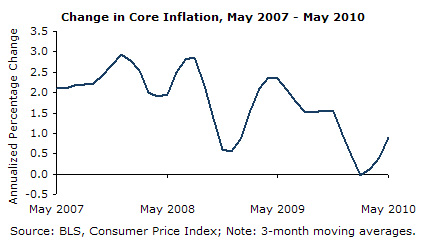July 16, 2010
July 16, 2010 (Prices Byte)
Energy Prices Have Dropped at a 17.4 Percent Annualized Rate Since January

The Consumer Price Index fell 0.1 percent in June. This is the third consecutive month of deflation in the broad measure of prices as energy prices continue to fall. The core index of inflation rose 0.2 percent in the month for the first time in nine months.
Energy prices had increased nearly 20 percent over 2009, but nearly half of that run-up has been erased since January, as energy prices have dropped at a 17.4 percent annualized rate since the beginning of the year.
As a result, prices overall have fallen at a 1.5 percent annualized rate, compared to annualized inflation rates of 0.9 percent from December to March and 2.5 percent from September to December.
Housing prices fell 0.1 percent in June, largely due to the lower price of household energy. Nevertheless, rent and Owners’ Equivalent Rent (OER) of primary residences continue to show considerable price restraint, each ticking up 0.1 percent in the month.
Inflation in OER has very slowly trended back up into positive territory in recent months. From December to March, prices fell at an 0.8 percent annualized rate, compared to a rise of 0.3 percent annualized rate over the last three months. With non-shelter core prices growing at a 1.6 percent annualized rate since March, real rents are still falling at a considerable pace.
Elsewhere in core prices, the picture is mixed. Apparel prices, which tend to be volatile, rose 0.8 percent in June and, having fallen 0.7 percent from March to April, are rising at a 1.3 percent annualized rate over the last three months, compared to -4.5 percent over the three months prior.
Medical care prices increased 0.3 percent in June, as hospital services jumped 0.6 percent in the month. The price of hospital services have grown at a 5.5 percent annualized rate over the last three months and 8.0 percent over the last six. By comparison, the prices of medical care commodities have grown at a 1.1 percent rate since March and a 4.4 percent rate since December.
Transportation prices fell 1.0 percent last month, largely due to falling fuel prices. In the last three months, motor fuel prices have fallen at a 37.3 percent annualized rate. Public transportation, which has been showing annualized inflation of 11.2 percent since March, actually fell 0.5 percent in June.
The price of used cars and trucks accelerated again in June — the 0.9 percent jump contributed to a 6.6 percent annualized rate over the last three months. This rate, while still high, is well below the 11.4 and 32.5 percent annualized rates from December to March and September to December, respectively. It is not clear whether the post-Cash-for-Clunkers disinflation in the used-car market is at an end.
Recreation prices rose 0.1 percent in June, and have risen at a 1.4 percent rate since March. Education prices rose another 0.3 percent in the month, but communication prices fell 0.2 percent. Combined, they have risen at a 1.9 percent annualized rate of inflation over the last three months.
Data at earlier stages of production are consistent with ongoing deflation. The intermediate core index of prices fell 0.4 percent in June– the first fall since last May. The rate of inflation in intermediate core goods continues to fall and now stands at a 3.8 percent annualized rate since March, compared to 8.7 percent the three months prior.
The more volatile crude core index fell 4.9 percent in July and has fallen at a 9.8 percent annualized rate over the last three months. Crude core prices had grown at a 56.5 percent annualized rate from December to March.
In the trade data, non-fuel import prices fell 0.6 percent — the third consecutive month of disinflation after rising 0.6 percent from March to April. Non-fuel import prices have grown at a 2.0 percent annualized rate over the last three months compared to 2.8 percent from December to March.
Despite inflation in several categories of consumer goods, inflation continues to be quite low, even excluding the recent fall in energy prices. With the housing market continuing to unwind, deflation in import and early-stage production indicate weak price pressure in consumer prices.






